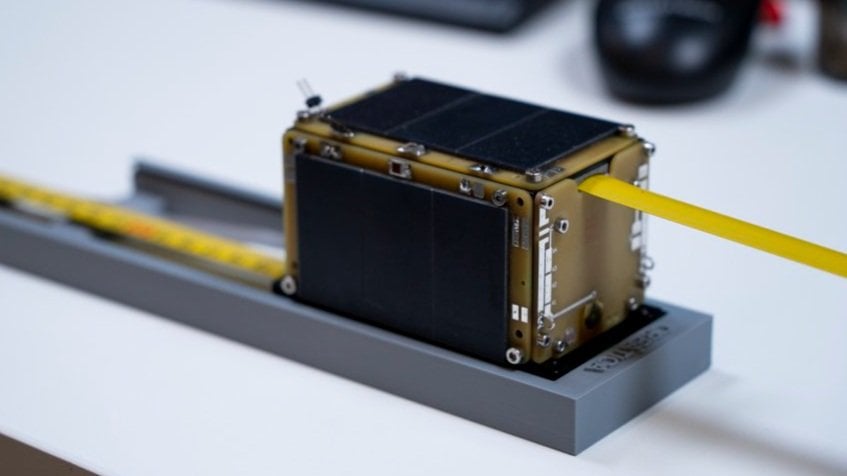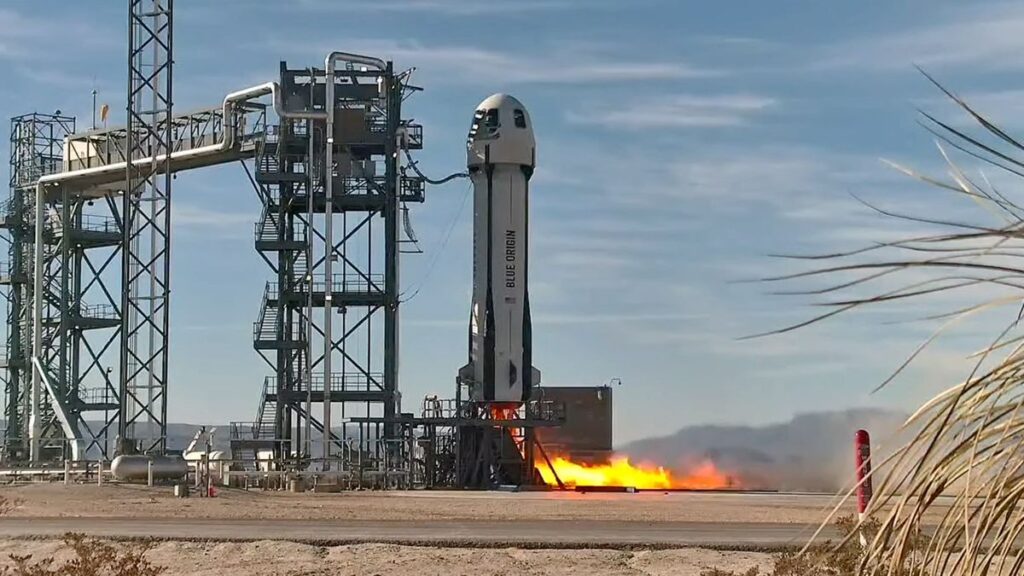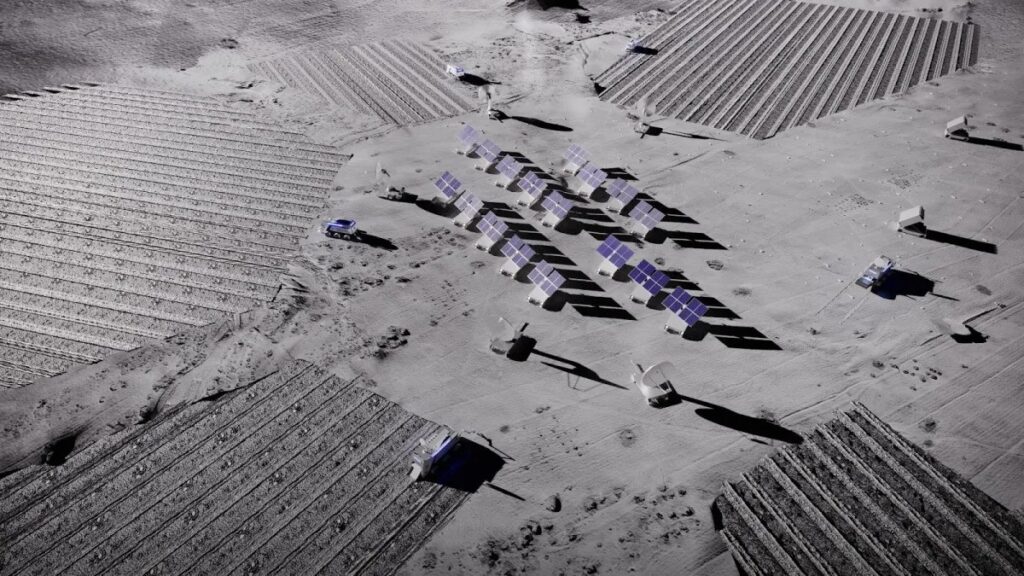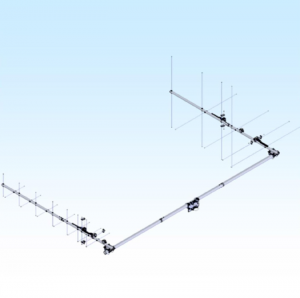AMSAT NEWS SERVICE
ANS-040
In this edition:
* AMSAT-EA's HADES-R Successfully Deployed and Transmitting Telemetry
* Blue Origin Simulates Lunar Gravity on Landmark New Shepard Flight
* Interlune Aims to Mine Lunar Helium-3 for Quantum Computing on Earth
* VUCC & DXCC Satellite Standings for February 2025
* Changes to AMSAT-NA TLE Distribution for February 7, 2025
* ARISS News
* Upcoming Satellite Operations
* AMSAT Ambassador Activities
* Satellite Shorts From All Over
The AMSAT News Service bulletins are a free, weekly news and information service of AMSAT, the Radio Amateur Satellite Corporation. ANS publishes news related to Amateur Radio in Space including reports on
the activities of a worldwide group of Amateur Radio operators who share an active interest in designing, building, launching and communicating through analog and digital Amateur Radio satellites.
The news feed on
https://www.amsat.org publishes news of Amateur Radio in Space as soon as our volunteers can post it.
Please send any amateur satellite news or reports to: ans-editor [at]
amsat.org
You can sign up for free e-mail delivery of the AMSAT News Service Bulletins via the ANS List; to join this list see:
https://mailman.amsat.org/postorius/lists/ans.amsat.org/
ANS-040 AMSAT News Service Weekly Bulletins
To: All RADIO AMATEURS
From: Radio Amateur Satellite Corporation
712 H Street NE, Suite 1653
Washington, DC 20002
DATE 2025 Feb 9
AMSAT-EA's HADES-R Successfully Deployed and Transmitting Telemetry
The HADES-R amateur radio satellite, operated by AMSAT-EA, has been successfully deployed and is functioning as expected. According to AMSAT-EA�??s update on January 23rd, the satellite is transmitting telemetry
data, and the initial health reports indicate that it is in good condition. The team is actively receiving data and preparing to transition the satellite into repeater mode once all necessary checks are completed. Amateur radio operators worldwide are encouraged
to share their telemetry reports to assist in confirming its operational status.
Deployment occurred on January 22nd at 15:42 UTC from the D-Orbit ION-SCV-016 orbital transfer vehicle (OTV) after launching on January 14th aboard a SpaceX Falcon 9 rocket as part of the Transporter-12 mission
from Vandenberg Space Force Base. The mission carried 131 payloads, including amateur radio satellites HADES-R and PARUS-T1. Due to the large number of satellites onboard, deployments were staggered over several days. Early signals were reported by amateur
operators, but official confirmation from AMSAT-EA followed later. Transmissions began shortly after deployment, though the FM repeater remains inactive as testing and validation processes continue.
HADES-R remains in good condition, with successful telemetry decodes reported worldwide. [Credit:
AMSAT-EA]
Designed to provide FM voice repeater capabilities, the satellite also supports various digital modes, including FSK telemetry and APRS at up to 1200 bps. It features a downlink frequency of 436.888 MHz, as
coordinated by the International Amateur Radio Union (IARU). While FM voice is its primary mission, it will also transmit experimental data and FSK telemetry. The uplink frequency is 145.925 MHz, supporting FM voice and various digital modes, including AX.25
and APRS. The FM repeater will operate without requiring a subtone, activating via squelch level.
As part of AMSAT-EA�??s ongoing efforts to expand amateur radio satellite operations, this spacecraft is the first of two planned replacements for HADES-D (SO-121). The second, HADES-ICM, is expected to launch
on the upcoming Transporter-13 mission in March 2025. Both satellites will provide FM and digital communication options, allowing amateur operators to engage in long-distance contacts. Additionally, HADES-ICM will host an experimental payload from the University
of Manchester�??s Smart IR/Graphene Engineering Innovation Centre (GEIC), testing a low-power active radiator under space conditions. AMSAT-EA has urged the amateur radio community to continue monitoring transmissions and sharing received telemetry data as the
satellite progresses towards full operational capability.
[ANS thanks
AMSAT-EA and Jose Rodriguez, EB1AO, for the above information]
Blue Origin Simulates Lunar Gravity on Landmark New Shepard Flight
Blue Origin successfully launched its NS-29 mission on February 4th, marking a significant milestone in suborbital research. The mission, which lifted off from the company�??s West Texas launch site at 11 a.m.
EST (16:00 UTC), was originally scheduled for January 28th but was delayed due to weather and technical issues. This flight was the 29th for the reusable New Shepard vehicle and featured a unique capability: the simulation of lunar gravity in suborbital space.
The NS-29 mission proceeded as planned, with both the booster and the crew capsule executing safe returns to Earth. The booster performed a controlled vertical landing on the designated pad, while the capsule
descended under parachutes, touching down in the West Texas desert approximately 10 minutes after launch. However, one of the capsule�??s three parachutes did not fully open. Blue Origin officials assured viewers during the live broadcast that the spacecraft
is designed to land safely even if not all parachutes fully deploy.
A key feature of this mission was its ability to generate lunar gravity forces�??a first for New Shepard. The capsule achieved this by rotating about 11 times per minute for two minutes using its reaction-control
thrusters. This capability was developed to support research on lunar-related technologies, benefiting the 30 payloads aboard the spacecraft. Among these, 29 experiments were specifically designed to test innovations applicable to the Moon�??s environment.
Blue Origin New Shepard NS-29 mission simulated lunar gravity to support lunar-related research for 30 payloads. [Credit:
Blue Origin]
Blue Origin categorized these experiments into six focus areas: in-situ resource utilization, dust mitigation, advanced habitation systems, sensors and instrumentation, small spacecraft technologies, and entry,
descent, and landing methods. Many of these experiments were backed by NASA�??s Flight Opportunities Program, underscoring the space agency�??s commitment to developing technology for lunar exploration. With the Artemis program aiming for long-term human presence
on the Moon, missions like NS-29 provide valuable data to refine critical systems for future lunar operations.
Notable NASA-supported experiments aboard NS-29 included the Electrostatic Dust Lofting project, which examined how lunar dust becomes electrically charged and moves when exposed to ultraviolet light. Another
key experiment, the Lunar-g Combustion Investigation, studied fire behavior in lunar gravity compared to Earth�??s, helping to enhance safety in future lunar habitats. Other experiments tested propellant management in low gravity, soil analysis tools, and small
satellite propulsion systems, all contributing to advancing space exploration technologies.
New Shepard, named after astronaut Alan Shepard, has been operational since its first uncrewed flight in April 2015. The vehicle made history in 2021 by carrying Jeff Bezos and three others on its first crewed
flight. While primarily known for space tourism, with nine of its 29 flights carrying passengers, the system continues to play a critical role in scientific research. The successful NS-29 mission not only demonstrated Blue Origin�??s ability to simulate lunar
gravity but also reinforced its contribution to advancing space technology in support of NASA�??s lunar ambitions.
[ANS thanks the Mike Wall,
Space.com, for the above information]
The 2025 AMSAT President�??s Club Coins Have Just Arrived!
Celebrating the 40th Anniversary of Amateur Radio on Human Spaceflight
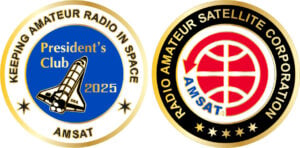
Help Support GOLF and Fox Plus.
Join the AMSAT President�??s Club today!
Interlune Aims to Mine Lunar Helium-3 for Quantum Computing on Earth
Interlune, a Seattle-based startup founded by former Blue Origin technologists, is aiming to harvest Helium-3 from the moon to support quantum computing applications on Earth. Helium-3, a rare isotope deposited
into the lunar regolith by solar wind, was first identified in samples brought back by NASA's Apollo missions. While the potential applications of Helium-3 have intrigued scientists for years, recent astrogeological research highlights significant challenges
in extracting the isotope. The U.S. Geological Survey (USGS) suggests that obtaining commercially viable amounts would require processing millions of tons of lunar regolith, a task comparable to large-scale mining operations on Earth.
Despite these hurdles, Interlune CEO Rob Meyerson remains optimistic. The company envisions an extraction system operating like an agricultural setup, with five harvesters each the size of a large SUV. Meyerson
acknowledges that it will take years before the company sees a financial return, but he emphasizes the growing demand for Helium-3 in quantum computing. This isotope plays a critical role in cooling superconducting quantum computers to temperatures close to
absolute zero. With quantum computing companies recognizing the need for a stable Helium-3 supply, Interlune believes now is the time to act.
Interlune is not the first to consider the commercial potential of lunar Helium-3. Apollo 17 astronaut and Interlune's executive chairman, Jack Schmitt, has long advocated its use in nuclear fusion reactors.
However, investment interest has shifted towards quantum computing applications, which promise quicker returns. Beyond computing, Helium-3 has other potential uses, including medical imaging and radiation detection. Interlune hopes to eventually supply tens
of kilograms per year, a goal that Meyerson believes is both realistic and financially sustainable given current market prices of around $20 million per kilogram.
Concept illustration of lunar Helium-3 mining involving harvesters, a solar power plant, rovers and return launchers. [Credit:
Interlune]
However, some experts remain skeptical about the feasibility of large-scale Helium-3 extraction from the moon. Laszlo Keszthelyi, a research geologist at the USGS Astrogeology Science Center, notes that lunar
Helium-3 concentrations range from just 2.4 to 26 parts per billion in Apollo samples. Given these figures, obtaining a single kilogram would require processing between 100,000 and 1 million tons of lunar soil. Keszthelyi stops short of dismissing the endeavor
outright, stating that the moon does contain resources�??it is merely a question of how they can be effectively utilized.
To address these concerns, Interlune is planning a resource development mission in 2027 to analyze Helium-3 concentrations at a potential mining site. This mission will be followed by a pilot plant in 2029
to demonstrate extraction and processing on the lunar surface. The company�??s initial lunar mission will launch through NASA�??s Commercial Lunar Payload Services initiative. Interlune is actively securing funding, having already raised $18 million, with plans
for another round of fundraising in the near future.
While profitability remains uncertain, experts acknowledge that Interlune�??s success will depend on the efficiency of its extraction methods. Chris Dreyer from the Colorado School of Mines notes that certain
minerals trap more Helium-3 than others, potentially increasing yield in select locations. However, large-scale excavation will be necessary, posing technical challenges, particularly with lunar dust. Despite these obstacles, Dreyer believes that iterative
development�??designing, testing, and improving equipment�??could make Interlune�??s ambitions feasible. As advances in space exploration continue, the prospect of mining Helium-3 on the moon is becoming an increasingly tangible reality.
[ANS thanks the Leonard David,
SpaceNews, for the above information]
VUCC & DXCC Satellite Standings for February 2025
VUCC Satellite Award/Endorsement Change Summary for January 01, 2025 to February 01, 2025
|
Callsign |
01/01/2025 |
02/01/2025 |
|
K8DP |
1629 |
1737 |
|
WA4NVM |
1653 |
1676 |
|
WC7V |
1451 |
1611 |
|
DF2ET |
1102 |
1602 |
|
DL5GAC |
New |
1576 |
|
DL2GRC |
1166 |
1501 |
|
AA5PK |
1426 |
1500 |
|
N8RO |
1401 |
1490 |
|
W5CBF |
1224 |
1326 |
|
N0JE |
1075 |
1225 |
|
MI6GTY |
970 |
1201 |
|
F4BKV |
1000 |
1200 |
|
KF7R |
1075 |
1175 |
|
N9EAT |
1029 |
1127 |
|
AC9O |
1001 |
1126 |
|
XE1AO |
1000 |
1111 |
|
WI7P |
882 |
1104 |
|
N3GS |
986 |
1103 |
|
OZ9AAR |
900 |
1100 |
|
JK2XXK |
503 |
1086 |
|
K9UO |
950 |
1030 |
|
KE8RJU |
950 |
1030 |
|
EA2AA |
875 |
1026 |
|
W2GDJ |
705 |
1022 |
|
JN2QCV |
726 |
1016 |
|
VE6WQ |
814 |
1007 |
|
K6FW |
951 |
1005 |
|
K7TAB |
814 |
1003 |
|
YO2CMI |
820 |
1003 |
|
PR8KW |
200 |
1001 |
|
KQ4DO |
827 |
952 |
|
N8JCM |
New |
952 |
|
FG8OJ |
737 |
935 |
|
HB9AOF |
725 |
907 |
|
KN2K |
808 |
907 |
|
JL1SAM |
601 |
905 |
|
VU2LBW |
603 |
902 |
|
KG0D |
801 |
900 |
|
W8LR |
825 |
897 |
|
N0GVK |
701 |
867 |
|
JS1LQI |
500 |
808 |
|
K0JM |
702 |
801 |
|
IK3ITB |
500 |
800 |
|
KK4YEL |
674 |
799 |
|
N5BO |
650 |
786 |
|
JG6CDH |
553 |
777 |
|
N8MR |
658 |
755 |
|
KS1G |
703 |
754 |
|
KC4CJ |
602 |
751 |
|
WD9EWK (DM43) |
734 |
737 |
|
KB1HY |
648 |
727 |
|
WA4HFN |
676 |
727 |
|
N3CAL |
480 |
686 |
|
AC9DX |
525 |
682 |
|
A65BR |
554 |
676 |
|
LY4AA |
New |
670 |
|
N7ZO |
350 |
669 |
|
AF5CC |
646 |
651 |
|
IK7FMQ |
500 |
651 |
|
N6UTC |
551 |
651 |
|
VE7PTN |
301 |
635 |
|
XE1UYS |
505 |
634 |
|
LA6OP |
New |
632 |
|
JN1BPM |
426 |
630 |
|
N5EKO |
500 |
622 |
|
SA0UNX |
362 |
617 |
|
F6GLJ |
400 |
609 |
|
EA3TA |
503 |
607 |
|
RA3DNC |
305 |
599 |
|
XE2YWH |
235 |
595 |
|
JA1GZK |
435 |
575 |
|
WB7VUF |
555 |
572 |
|
VE4MM |
536 |
561 |
|
HB9GWJ |
476 |
553 |
|
DL6KBG |
331 |
550 |
|
WB7QXU |
500 |
550 |
|
W9FF |
New |
545 |
|
KH6WI |
300 |
530 |
|
KP3V |
402 |
526 |
|
KO9A |
434 |
524 |
|
AD2DD |
356 |
517 |
|
SV8CS |
New |
511 |
|
VA3VGR |
352 |
509 |
|
HP2VX |
496 |
508 |
|
KF2T |
111 |
505 |
|
E70A |
New |
504 |
|
AL7ID |
320 |
502 |
|
N9ZTS |
400 |
501 |
|
I3BUI |
New |
500 |
|
IK0USO |
118 |
500 |
|
JR0GAS |
360 |
500 |
|
KA9CFD |
New |
500 |
|
PA7RA |
300 |
495 |
|
N6PAZ |
350 |
479 |
|
AB1OC |
407 |
476 |
|
W3TI |
103 |
465 |
|
N7UJJ |
308 |
462 |
|
DL8GAM |
375 |
450 |
|
N8URE (FM19) |
430 |
450 |
|
AG4W |
161 |
438 |
|
WO3T |
New |
437 |
|
DJ7NT |
234 |
432 |
|
JI5USJ |
236 |
425 |
|
K4RGK |
362 |
421 |
|
F6EQD |
311 |
420 |
|
HC2FG |
350 |
413 |
|
JE3HCZ |
103 |
410 |
|
W3VHF |
250 |
406 |
|
ZS2BK |
305 |
405 |
|
NJ2DX |
100 |
404 |
|
SP5ULN |
156 |
404 |
|
JO4JKL |
135 |
401 |
|
KF0QS |
301 |
400 |
|
ON4CCN |
208 |
400 |
|
K6VHF |
276 |
376 |
|
W6AER |
302 |
376 |
|
HB9RYZ |
248 |
365 |
|
KB3IAI |
254 |
358 |
|
KE8AKW |
329 |
358 |
|
HB9BIN |
New |
356 |
|
K3HPA |
300 |
350 |
|
LA9KY |
New |
347 |
|
N8HRZ |
New |
337 |
|
AG1A |
New |
335 |
|
JH8RZJ |
New |
328 |
|
W0PR |
New |
327 |
|
N4QWF |
115 |
325 |
|
JH0BBE |
322 |
324 |
|
N9XG |
252 |
310 |
|
KG4ERR |
New |
301 |
|
IK8YTA |
162 |
300 |
|
K7OGW |
New |
300 |
|
K9JKM |
201 |
300 |
|
W6CZ |
New |
300 |
|
XE1BMG |
120 |
300 |
|
KG0I |
New |
297 |
|
JE2UFF |
185 |
280 |
|
JF3MKC |
200 |
280 |
|
KB9DAK |
171 |
278 |
|
W6IA |
100 |
278 |
|
AA0MZ |
276 |
277 |
|
WA3YDZ |
New |
271 |
|
IN3EQZ |
New |
268 |
|
DL5KUA |
128 |
266 |
|
W0BZ |
New |
256 |
|
K5WO |
New |
255 |
|
AA0K |
New |
253 |
|
SP7JS |
New |
253 |
|
KH6WI/W9 (EN54) |
New |
250 |
|
I1FQH |
173 |
249 |
|
BX1AD |
New |
237 |
|
WA8ZID |
226 |
230 |
|
KB4DSL |
127 |
226 |
|
N7GR |
205 |
226 |
|
DF5SF |
New |
217 |
|
KB2MFS |
New |
215 |
|
IK0WRB |
123 |
213 |
|
PU5DDC |
200 |
213 |
|
KR7LD |
New |
211 |
|
RA0FF |
New |
211 |
|
PY2YJ |
150 |
210 |
|
N4UFO |
New |
206 |
|
K0JQZ |
New |
205 |
|
N2WLS |
104 |
205 |
|
WD5GRW |
New |
205 |
|
9A2GA |
New |
202 |
|
EK/RX3DPK |
New |
200 |
|
WD9EWK (DM22) |
198 |
200 |
|
WD9EWK (DM31) |
187 |
200 |
|
W2HRO |
New |
192 |
|
OK1IN |
New |
190 |
|
WD9EWK (DM42) |
183 |
189 |
|
AI9IN |
150 |
175 |
|
RA3LAS |
New |
172 |
|
WD9EWK (DM45) |
165 |
170 |
|
NK0S |
167 |
169 |
|
7J1ADJ |
New |
164 |
|
W4DFU |
151 |
163 |
|
JK4JMO |
New |
161 |
|
DH0GSU |
152 |
156 |
|
AE5AU |
New |
153 |
|
KJ7SXR |
New |
151 |
|
EA4DEI |
100 |
150 |
|
G4BWP |
New |
150 |
|
K2MJP |
125 |
150 |
|
KD8RTT |
101 |
150 |
|
VE3JO |
117 |
149 |
|
IC8TEM |
New |
147 |
|
VE3AAZ |
118 |
147 |
|
SV8CKM |
New |
140 |
|
WD9EWK (DM25) |
120 |
138 |
|
W0SX |
New |
134 |
|
BD8CBU |
New |
132 |
|
BI8FFH |
New |
132 |
|
DH9DX |
New |
131 |
|
PU8MRS |
127 |
129 |
|
XE2/CO6LAR |
New |
129 |
|
N6UTC (DM05) |
101 |
128 |
|
ER1KW |
New |
127 |
|
XE2YWH (DL82 - D |
114 |
119 |
|
XE2YWH (DL82) |
114 |
119 |
|
WK7G |
New |
118 |
|
YC1RIK |
New |
114 |
|
NC0Q |
New |
108 |
|
XE1RCU |
New |
108 |
|
K7AXA |
New |
104 |
|
XE1YD |
New |
104 |
|
BG6HXD |
New |
103 |
|
KK7OVF |
New |
103 |
|
N6NU |
New |
103 |
|
YO6OEV |
New |
103 |
|
4A2MAX |
New |
102 |
|
BI1QGX |
New |
102 |
|
DL3NGN |
New |
102 |
|
N2YZH |
New |
101 |
|
SV2DSJ |
New |
101 |
|
BA7LVG |
New |
100 |
|
K9DOG |
New |
100 |
|
KD2YIB |
New |
100 |
|
LZ3SV |
New |
100 |
|
N5YIZ |
New |
100 |
|
VK5DG |
New |
100 |
|
W4BB |
New |
100 |
|
W4XP |
New |
100 |
|
YB1RQX/P |
New |
100 |
DXCC Satellite Award/Endorsement Change Summary for January 01, 2025 to February 01, 2025
|
Callsign |
01/01/2025 |
02/01/2025 |
|
OE9DGV |
212 |
213 |
|
YO3APJ |
162 |
165 |
|
EA2AA |
157 |
158 |
|
HB9RYZ |
152 |
153 |
|
IK4DRY |
122 |
144 |
|
RA3DNC |
131 |
143 |
|
IK7FMQ |
120 |
128 |
|
SM2OAN |
109 |
117 |
|
G4BWP |
100 |
105 |
|
R5DT |
New |
102 |
|
WI7P |
New |
102 |
|
I4MKN |
New |
101 |
|
LY4AA |
New |
100 |
|
N0GVK |
New |
100 |
N0GVK is first DXCC Satellite holder from EN00. Congratulations to the new DXCC Satellite holders!
[ANS thanks Jon Goering, N7AZ, for the above information]
Need new satellite antennas?
Purchase an M2 LEO-Pack from the AMSAT Store!
When you purchase through AMSAT, a portion of the proceeds goes towards
Keeping Amateur Radio in Space.
https://amsat.org/product-category/hardware/
Changes to AMSAT-NA TLE Distribution for February 7, 2025
Two Line Elements or TLEs, often referred to as Keplerian elements or keps in the amateur community, are the inputs to the SGP4 standard mathematical model of spacecraft orbits used by most amateur tracking
programs. Weekly updates are completely adequate for most amateur satellites. TLE bulletin files are updated daily in the first hour of the UTC day. New bulletin files will be posted immediately after reliable elements become available for new amateur satellites.
More information may be found at
https://www.amsat.org/keplerian-elements-resources/.
NOTICE: In an effort to minimize confusion between sources of two line element sets, AMSAT is adopting the convention of listing the USSF/NORAD Satellite Catalog name first, followed by any secondary name or
names in parentheses. For example, "POEM 4 (BGS ARPIT)" was added recently where "POEM 4" is the name that appears in the US Space Force Satellite Catalog, and "BGS ARPIT" is the name best known within the amateur satellite community. Expect name changes for
affected satellites in the coming weeks as this change is fully implemented.
The following satellite has been added to this week's AMSAT TLE distribution:
HyperView 1G (RS66S) NORAD Cat ID 61772 Downlink 436.540 MHz
OBJECT BA (ZIMSAT 2) NORAD Cat ID 71783 Downlink 437.050 MHz
[ANS thanks
AMSAT Orbital Elements page for the above information]
ARISS NEWS
Amateurs and others around the world may listen in on contacts between amateurs operating in schools and allowing students to interact with astronauts and cosmonauts aboard the International Space Station.
The downlink frequency on which to listen is 145.800 MHz worldwide.
+ Recently Completed
Aznakaevo Schools, Aznakaevo, Aznakaevsky District, Republic of Tatarstan, Russia, direct via RC4P
The ISS callsign was RS�?ISS
The scheduled crewmember was Ivan Vagner
The ARISS mentor was RV3DR
Contact was successful: Sat 2025-02-01 11:15 UTC
Congratulations to the Aznakaevo School students, Ivan, mentor RV3DR, and ground station RC4P!
Public Primary School, La Laupie, France, direct via F5KLF
The ISS callsign was OR4ISS
The scheduled crewmember was Don Pettit KD5MDT
The ARISS mentor was F6ICS
Contact was successful: Fri 2025-02-07 14:27:07 UTC
Congratulations to the La Laupie Public Primary School students, mentor F6ICS, and ground station F5KLF!
+ Upcoming Contacts
Kant, Kaliningrad, Russia
The ISS callsign is presently scheduled to be RS�?ISS
The scheduled crewmember is Alex Gorbunov
The ARISS mentor is RV3DR
Contact is go for Tue 2025-02-11 09:35 UTC
City of Clifton Arts Center & Sculpture Park, Clifton, NJ, direct via W2NPT
The ISS callsign is presently scheduled to be NA1SS
The scheduled crewmember is Don Pettit KD5MDT
The ARISS mentor is AA6TB
Contact is go for: Wed 2025-02-12 18:14:13 UTC
Many times a school may make a last minute decision to do a Livestream or run into a last minute glitch requiring a change of the URL but we at ARISS may not get the URL in time for publication. You can always
check https://live.ariss.org/ to see if a school is Livestreaming.
The crossband repeater continues to be active (145.990 MHz up {PL 67} & 437.800 MHz down). If any crewmember is so inclined, all they have to do is pick up the microphone, raise the volume up, and talk on the
crossband repeater. So give a listen, you just never know.
The packet system is also active (145.825 MHz up & down).
As always, if there is an EVA, a docking, or an undocking; the ARISS radios are turned off as part of the safety protocol.
Note, all times are approximate. It is recommended that you do your own orbital prediction or start listening about 10 minutes before the listed time.
The latest information on the operation mode can be found at
https://www.ariss.org/current-status-of-iss-stations.html
The latest list of frequencies in use can be found at
https://www.ariss.org/contact-the-iss.html
[ANS thanks Charlie Sufana, AJ9N, one of the ARISS operation team mentors for the above information]
Upcoming Satellite Operations
None currently posted.
A growing number of satellite rovers are currently engaged in sharing their grid square activations on
https://hams.at. By visiting the website, you gain easy access to comprehensive information about the operators responsible for activating specific grid squares. Additionally, you have the ability to assess the match score between
yourself and a particular rover for a given pass, while also being able to identify the upcoming satellite passes that are accessible from your location.
[ANS thanks Ian Parsons,
K5ZM, AMSAT rover page manager, for the above information]
AMSAT Ambassador Activities
AMSAT Ambassadors provide presentations, demonstrate communicating through amateur satellites, and host information tables at club meetings, hamfests, conventions, maker faires, and other events.
AMSAT Ambassador Clint Bradford, K6LCS, says,
�??Think a 75-minute presentation on �??working the easy satellites�?� would be appropriate for your club or event? Let me know by emailing me at k6lcsclint (at) gmail (dot) com or calling me at 909-999-SATS (7287)!�?�
Clint has NEVER given the exact same show twice: EACH of the 150+ presentations so far has been customized/tailored to their audiences.
Yuma Hamfest and Southwestern Division Convention - February 14th thru 15th, 2025
Yuma County Fairgrounds
2520 East 32nd Street
Yuma, AZ 85365
https://www.yumahamfest.com/
N1UW
Midwinter Madness Hamfest - March 22nd, 2025
Buffalo Civic Center
1306 County Road 134
Buffalo MN 55313
https://k0ltc.org/midwinter-madness/
K�?JM, AD�?HJ, KE�?PBR
Southeastern VHF Conference 2025 - April 4th thru 5th, 2025
Quality Inn Exit 4
3095 Wilma Rudolph Boulevard
Clarksville, TN 37040
https://svhfs.org/wp/2025-conference/
W4FCL
[ANS thanks Bo Lowrey,
W4FCL, Director �?? AMSAT Ambassador Program, for the above information]
AMSAT Remove Before Flight Key Tags Now Available
Yes, These are the Real Thing!
Your $20 Donation Goes to Help Fly a Fox-Plus Satellite
Includes First Class Postage (Sorry - U.S. Addresses Only)
Order Today at
https://www.amsat.org/product/amsat-remove-before-flight-keychain
Satellite Shorts From All Over
+ AO-73 was switched back to full-time transponder mode on February 3rd, 2025. The U/V linear transponder is now operating 24/7 after a month-long period of telemetry collection on the satellite�??s electrical
power system. While some signs of reduced battery capacity are present, the two Lithium-Ion cells continue to perform well, supporting full transponder operation throughout the orbit. AO-73 features an inverting SSB/CW transponder with an uplink passband from
435.150 to 435.130 MHz (LSB) and a downlink passband from 145.950 to 145.970 MHz (USB). With the transponder active, the satellite also transmits BPSK telemetry on 145.935 MHz at 40mW. The collected telemetry data helps assess the long-term health of the 11-year-old
satellite. (ANS thanks David Bowman, G0MRF for the above information)
+ NASA has confirmed the crew for Axiom Mission 4, set to launch no earlier than spring 2025 aboard a SpaceX Dragon spacecraft from Kennedy Space Center. The mission will be commanded by former NASA astronaut
Peggy Whitson, with ISRO astronaut Shubhanshu Shukla as pilot and ESA�??s S�?awosz Uzna�?ski-Wi�?niewski and Hungary�??s Tibor Kapu as mission specialists. Once docked at the International Space Station, the crew will spend up to 14 days conducting science, outreach,
and commercial activities. This mission includes the first ISRO astronaut aboard the station and the first astronauts from Poland and Hungary to stay there. NASA sees private astronaut missions as a way to expand access to space and support commercial activity
in low Earth orbit. As the agency shifts focus to deep space exploration through Artemis missions, partnerships with private companies help maintain a human presence in space and support research in microgravity. (ANS thanks
NASA for the above information)
+ Indian Space Research Organization's (ISRO) NVS-02 navigation satellite, launched on January 28th aboard a Geostationary Satellite Launch Vehicle (GSLV) Mark 2 rocket, was intended to replace the IRNSS-1E
satellite in geostationary orbit as part of India�??s NavIC navigation system. However, ISRO confirmed on February 2nd that the satellite�??s onboard propulsion system failed due to oxidizer valves not opening, preventing it from reaching its intended orbit. As
a result, NVS-02 remains stuck in an elliptical transfer orbit with a perigee of 165 kilometers (103 miles) and an apogee of 37,582 kilometers (23,354 miles), making it vulnerable to reentry due to atmospheric drag. While the spacecraft�??s solar panels and
other systems are functioning normally, ISRO is exploring alternative mission strategies to utilize it in its current orbit. The 2,250-kilogram (4,960-pound) satellite was the second of five planned NavIC satellites aimed at enhancing regional navigation services.
Its failure raises concerns about the future deployment of the NavIC system, and it remains unclear if any backup propulsion systems could adjust its orbit to prevent early reentry. (ANS thanks
SpaceNews for the above information)
+ AstroForge, a U.S.-based asteroid mining company, has identified asteroid 2022 OB5 as the target for its upcoming Mission 2, Odin, set to launch in February 2025 aboard a SpaceX Falcon 9 rocket. Odin will
serve as a scouting spacecraft, flying as a secondary payload alongside Intuitive Machines' IM-2 lunar lander, and will separate after the rocket�??s upper stage fires for the moon. The spacecraft is expected to take about 300 days to reach the asteroid, where
it will conduct a flyby to gather crucial imagery and assess the rock�??s mining potential. This mission paves the way for AstroForge�??s next endeavor, Vestri, which aims to land on the asteroid and initiate resource extraction, potentially launching in late
2025 as part of another rideshare mission. AstroForge, founded in January 2022, seeks to develop sustainable methods for mining precious metals from asteroids, although its first mission, Brokkr-1, launched in April 2023, failed to activate its onboard refinery
technology. The company has also secured a contract with Stoke Space for future launches aboard the Nova rocket to support its ambitious mining goals. (ANS thanks
Space.com for the above information)
Join AMSAT today at
https://launch.amsat.org/
In addition to regular membership, AMSAT offers membership to:
* Societies (a recognized group, clubs or organization).
* Primary and secondary school students are eligible for membership at one-half the standard yearly rate.
* Post-secondary school students enrolled in at least half-time status shall be eligible for the student rate for a maximum of 6 post-secondary years in this status.
* Memberships are available for annual and lifetime terms.
Contact info [at]
amsat.org for additional membership information.
73 and remember to help Keep Amateur Radio in Space!
This week's ANS Editor, Mitch Ahrenstorff, AD�?HJ
mahrenstorff [at] amsat.org
